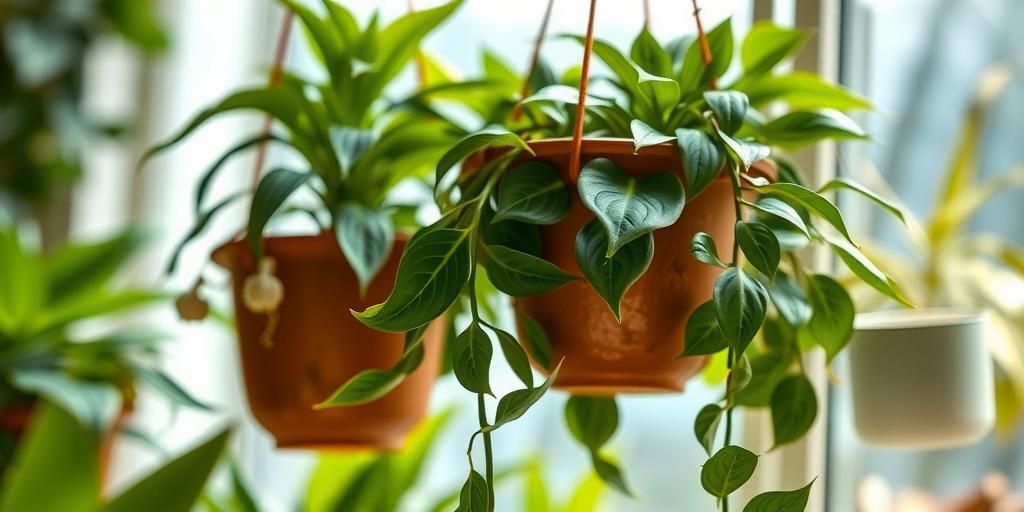
10 Easy Care Hanging Plants That Thrive in Low Light (2025)
Discover the best low-light hanging plants that are easy to care for! Perfect for beginners, these indoor plants add greenery to any space without needing direct sunlight.
Introduction
Do you love houseplants but struggle with low-light spaces? You’re not alone! Many homes and offices lack bright, sunny windows—but that doesn’t mean you can’t enjoy lush, trailing greenery. In fact, some of the easiest plants to care for thrive in low light and look stunning in hanging planters! Whether you’re a busy plant parent or a newbie looking for foolproof options, this guide covers the best low-light hanging plants that require minimal attention. Let’s dive in!
Why Choose Hanging Plants for Low Light?
Hanging plants are a fantastic solution for small or dimly lit spaces. They bring life to areas where floor or tabletop plants might not thrive, and their vertical growth helps maximize limited square footage. But why are they such a great fit for low-light conditions?
Benefits of Hanging Plants in Small or Dim Spaces
Hanging plants instantly add greenery without taking up valuable floor space. In apartments, offices, or rooms with few windows, they can brighten up dark corners and create a more inviting atmosphere. Plus, many low-light hanging plants are naturally adapted to survive under tree canopies in the wild, making them perfect for indoor conditions with limited sunlight.
How Low-Light Plants Adapt to Indoor Conditions
Plants that thrive in low light have evolved to make the most of minimal sunlight. Many have larger, darker leaves that absorb light more efficiently, while others grow slowly to conserve energy. This makes them ideal for indoor environments where natural light is scarce.
Space-Saving Advantages of Vertical Greenery
Hanging plants allow you to utilize vertical space, which is especially useful in small homes. Instead of crowding shelves or tabletops, you can suspend plants from ceilings, walls, or hooks, keeping surfaces clear while still enjoying lush foliage.
Top 10 Low-Light Hanging Plants for Easy Care
If you’re looking for the best low-maintenance hanging plants that thrive in dim conditions, here are ten excellent choices:
1. Pothos (Epipremnum aureum)
Pothos is one of the most forgiving plants you can own. It thrives in low to moderate light and can survive occasional neglect. Its long, trailing vines grow quickly, making it perfect for hanging baskets. Plus, it’s easy to propagate—just snip a stem and place it in water!
2. Spider Plant (Chlorophytum comosum)
Spider plants are air-purifying champions that do well in indirect light. They produce “spiderettes,” or baby plants, which dangle from the mother plant and can be replanted. They’re also drought-tolerant and safe for pets, making them a worry-free choice.
3. Heartleaf Philodendron (Philodendron hederaceum)
This fast-growing vine has charming heart-shaped leaves and adapts well to low light. It’s beginner-friendly and only needs watering when the soil dries out. Its trailing habit makes it ideal for hanging planters.
4. English Ivy (Hedera helix)
A classic trailing plant, English Ivy thrives in shaded spots. You can let it cascade from a hanging basket or train it to climb a trellis. It prefers cooler temperatures, so it’s great for rooms that don’t get too warm.
5. String of Hearts (Ceropegia woodii)
With delicate, heart-shaped leaves on long trailing vines, this plant adds a whimsical touch. While it prefers bright, indirect light, it can tolerate lower light conditions. It’s also drought-resistant, so it won’t mind if you forget to water it occasionally.
6. ZZ Plant (Zamioculcas zamiifolia)
The ZZ plant is nearly indestructible—it can survive in near-darkness and requires very little water. Its glossy, dark green leaves add a modern touch to any space. Since it grows slowly, it’s perfect for low-maintenance plant lovers.
7. Maidenhair Fern (Adiantum spp.)
This fern’s lacy, delicate fronds create a soft, elegant look. It prefers humidity and indirect light, so it’s great for bathrooms or kitchens. Just be sure to keep the soil consistently moist—it doesn’t like drying out.
8. Peperomia (Peperomia spp.)
Peperomias are compact, low-maintenance plants with a variety of leaf shapes and colors. Varieties like “Peperomia Hope” have trailing stems that look great in hanging baskets. They only need water when the soil is dry, making them easy to care for.
9. Arrowhead Plant (Syngonium podophyllum)
This adaptable plant can thrive in low light, though it grows faster in bright, indirect light. Its leaves change shape as they mature, adding visual interest. It’s also easy to propagate—just take a cutting and place it in water.
10. Boston Fern (Nephrolepis exaltata)
Boston ferns are lush and feathery, making them perfect for hanging baskets. They love humidity and indirect light, so they do well in bathrooms or near a humidifier. Just be sure to water them regularly to keep the soil moist.
Tips for Growing Hanging Plants in Low Light
Even low-maintenance plants need the right care to thrive. Here’s how to keep your hanging greenery healthy:
Best Soil Types for Drainage and Moisture Retention
Use a well-draining potting mix to prevent root rot. Many low-light plants prefer soil that retains some moisture but doesn’t stay soggy. Adding perlite or orchid bark can improve drainage.
How Often to Water Low-Light Hanging Plants
Since low-light plants grow slower, they need less water than sun-loving varieties. Always check the soil before watering—stick your finger in about an inch deep. If it’s dry, it’s time to water.
Ideal Placement Away from Direct Sunlight
Avoid placing low-light plants in direct sunlight, which can scorch their leaves. Instead, position them in bright, indirect light or shaded corners. North-facing windows or spots a few feet away from east/west windows are ideal.
Fertilizing Tips for Slow-Growing Plants
Low-light plants don’t need frequent fertilizing. A diluted, balanced houseplant fertilizer every 2-3 months during the growing season (spring and summer) is usually enough.
Pruning and Maintenance for Healthy Growth
Trim dead or yellowing leaves to encourage new growth. For trailing plants like pothos or philodendron, occasional pruning helps maintain a fuller shape.
Common Mistakes to Avoid
Even with easy-care plants, a few missteps can lead to problems. Here’s what to watch out for:
Overwatering vs. Underwatering
Overwatering is the most common killer of houseplants. Low-light plants dry out slower, so they need less frequent watering. On the flip side, don’t neglect them completely—check the soil regularly.
Choosing the Wrong Plant for Your Space
Not all “low-light” plants are the same. Some, like ZZ plants, can handle near-darkness, while others, like ferns, still need bright indirect light. Match the plant to your actual light conditions.
Ignoring Humidity Needs
Some low-light plants, like ferns and ivy, thrive in humid environments. If your air is dry, mist them occasionally or use a humidifier to keep them happy.
Not Rotating Plants for Even Growth
Plants in low light tend to grow toward the nearest light source. Rotate your hanging baskets every few weeks to ensure even growth and prevent lopsidedness.
By following these tips and choosing the right plants, you can enjoy lush, thriving greenery—even in the darkest corners of your home!
Conclusion
Who says you need a sunny windowsill to enjoy beautiful hanging plants? With these low-light champions, you can easily add greenery to any corner of your home—no green thumb required! Pick your favorites, hang them up, and watch them thrive with minimal effort. Ready to transform your space? Start with a Pothos or Spider Plant for an easy, foolproof option. Happy planting!
